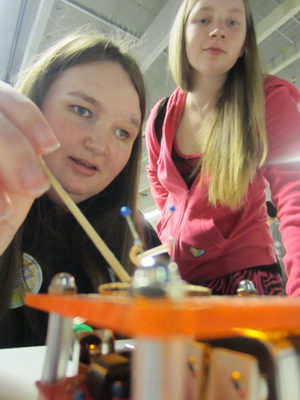Learning About Sensorimotor Neural Engineering
Through a unique collaboration with the DO-IT Center, the Center for Neurotechnology (CNT) hosted a learning lab for twenty-five DO-IT students with disabilities.

During the learning lab, students heard a presentation about sensorimotor neural engineering and learned about research collaborations facilitated by the CNT. They learned about optical illusions and signal processing in the visual cortex. They saw examples of brains from various small animals, and were able to use Spikerboxes that demonstrate action potentials in cockroach legs. Students were able to stimulate the legs in a variety of ways to observe the signals produced. A highly-rated activity involved operating a wheeled robot by using electrodes that sensed signals associated with muscle movement.
In a post-activity survey, 92% of the students stated that activities like the CNT learning lab can motivate youth with disabilities to pursue science and engineering fields. When asked if participation in the learning lab increased their interest in sensorimotor neural engineering, 80% of students said "yes." Student comments included:
- "I want to learn more about implantable devices."
- "It is cool-almost science fiction to control something with your brain!"
- "I want to know more about this field. Before I had no interest in this field."
Students involved in the activity helped create a video to share their experience and demonstrate the value of the activity to others. Students decided what type of information should be in the video, the composition of pictures and video clips, and created the narration. The video is available online at the CNT website at www.csne-erc.org/news/csnedo-it-event.
This collaborative activity with CNT benefitted society by engaging students with disabilities to increase their interest in STEM fields—especially sensorimotor neural engineering. The activity serves as a model for others who want to promote STEM fields to youth with disabilities, and the student video posted online can help students get excited about the field.